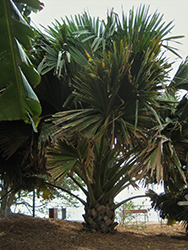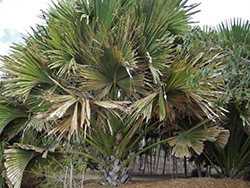It's all about ...
plants

Height: 80 feet
Spread: 20 feet
Sunlight:
![]()
Hardiness Zone: 10a
Description:
This single stemmed palm is one of the largest in the world, up to 100 feet tall; enormous, fan shaped, dark green leaves emerge from the crown; flowers and fruits only once, after 50 to 75 years, then the plant dies; an incredible large landscape accent
Ornamental Features
Talipot Palm has attractive dark green evergreen foliage on a tree with the bulk of the canopy held atop a towering trunk or stem. The enormous fan-shaped palmate leaves are highly ornamental and remain dark green throughout the winter. The rough khaki (brownish-green) bark adds an interesting dimension to the landscape.
Landscape Attributes
Talipot Palm is a dense evergreen tree with a strong central leader and a towering form, with a high canopy of foliage concentrated at the top of the plant. Its strikingly bold and coarse texture can be very effective in a balanced landscape composition.
This tree will require occasional maintenance and upkeep, and should not require much pruning, except when necessary, such as to remove dieback. It has no significant negative characteristics.
Talipot Palm is recommended for the following landscape applications;
- Accent
- Shade
- Vertical Accent
Planting & Growing
Talipot Palm will grow to be about 80 feet tall at maturity, with a spread of 20 feet. It has a high canopy of foliage that sits well above the ground, and should not be planted underneath power lines. As it matures, the lower branches of this tree can be strategically removed to create a high enough canopy to support unobstructed human traffic underneath. It grows at a slow rate, and under ideal conditions can be expected to live for 75 years or more.
This tree should only be grown in full sunlight. It is very adaptable to both dry and moist growing conditions, but will not tolerate any standing water. It is considered to be drought-tolerant, and thus makes an ideal choice for xeriscaping or the moisture-conserving landscape. This plant does not require much in the way of fertilizing once established. It is not particular as to soil type or pH. It is somewhat tolerant of urban pollution. This species is not originally from North America..
This plant is not reliably hardy in our region, and certain restrictions may apply; contact the store for more information.

